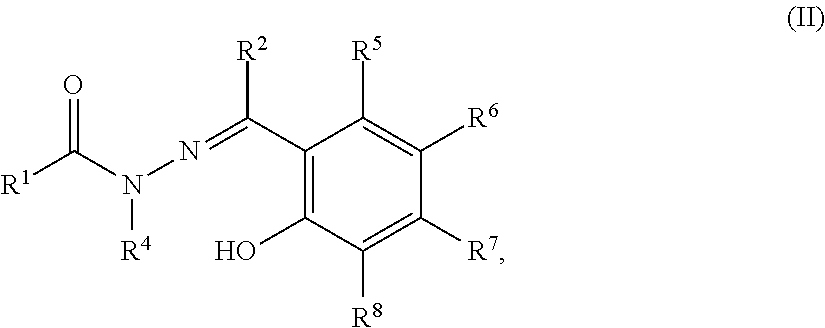Acyl hydrazones as bleach-boosting active substances
a technology of acyl hydrazone and active substances, which is applied in the direction of organic/inorganic per-compound compounding agents, organic detergent compounding agents, detergent compositions, etc., can solve the problem of high affinity of hydrocolloids
- Summary
- Abstract
- Description
- Claims
- Application Information
AI Technical Summary
Benefits of technology
Problems solved by technology
Method used
Image
Examples
examples
[0061]The primary washing power was measured at the temperatures listed in the following Table using cotton substrates that had been stained with standardized soils. The substrates were washed under the same conditions with a washing agent (V1) containing 12.5 wt % sodium percarbonate and 3.5 wt % TAED or with an otherwise identically formulated agent (M1), to which 0.2 wt % 4-(2-(2-((2-hydroxyphenylmethyl)methylene)-hydrazinyl)-2-oxoethyl)-4-methylchloride had been added. The treated material substrate was then dried and the color was measured. In the following Table the brightness value of the cotton sample is presented as the average of 6 separate measurements.
TABLE 1Bleaching Power [remission value in %]Stain; TemperatureV1M1Chocolate milk / carbon black; 30° C.59.362.7Cocoa; 60° C.71.272.1Porridge; 60° C.76.978.3Drinking chocolate; 40° C.61.362.4Chocolate cream; 30° C.77.678.4“Mole”; 30° C.72.174.2
PUM
 Login to View More
Login to View More Abstract
Description
Claims
Application Information
 Login to View More
Login to View More - R&D
- Intellectual Property
- Life Sciences
- Materials
- Tech Scout
- Unparalleled Data Quality
- Higher Quality Content
- 60% Fewer Hallucinations
Browse by: Latest US Patents, China's latest patents, Technical Efficacy Thesaurus, Application Domain, Technology Topic, Popular Technical Reports.
© 2025 PatSnap. All rights reserved.Legal|Privacy policy|Modern Slavery Act Transparency Statement|Sitemap|About US| Contact US: help@patsnap.com



